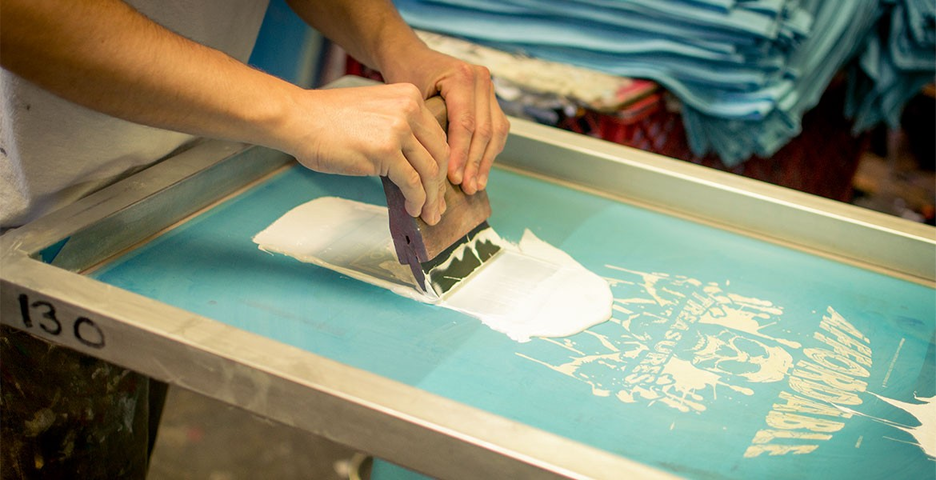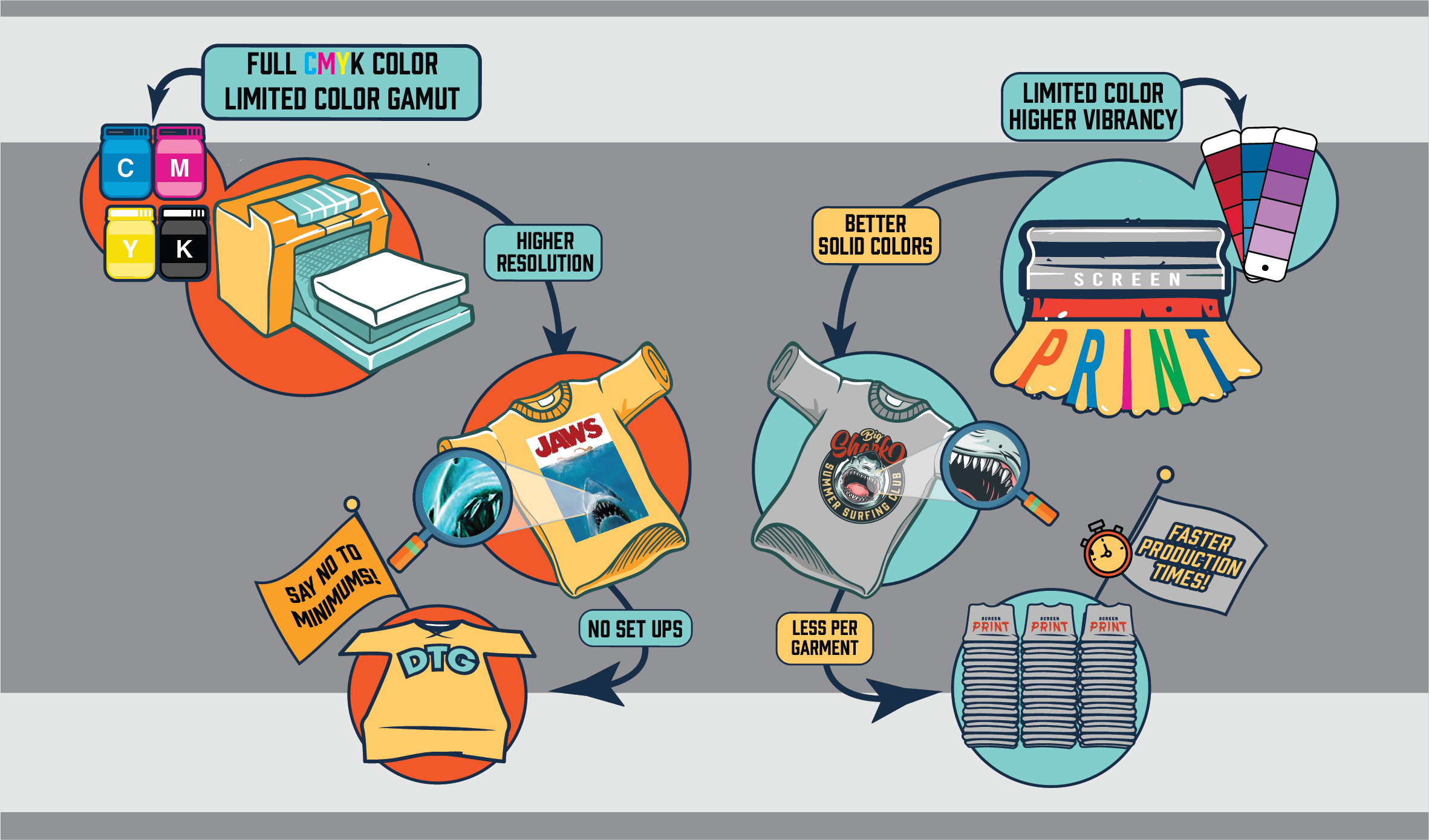The smart Trick of Tx Tees That Nobody is Discussing
The smart Trick of Tx Tees That Nobody is Discussing
Blog Article
The smart Trick of Tx Tees That Nobody is Discussing
Table of ContentsTx Tees for BeginnersAbout Tx Tees4 Simple Techniques For Tx TeesTx Tees - TruthsThe Facts About Tx Tees RevealedAbout Tx TeesThe 5-Minute Rule for Tx Tees
Add up various other prices, like the number of energies it takes to run the shop and the cost of ink and solution per style. Take the print listed below.The emulsion must only be a couple of cents considering that you 'd just require to layer one screen for this job. Generally, printers attempt to make up to 45% earnings on a print job.

With DTF, you can publish a handful of shirts, or simply one. Make use of the exact same calculator as the area over to compute just how much revenue you 'd make using DTF transfers. Compare the costs and revenues to whichever approach speaks finest to your arrangement and procedure. Both display printing and DTF have their niches on the planet.
Some Ideas on Tx Tees You Need To Know
The most effective way to know? Ask around and see what printing shop like your own are doing. custom cap printing. Attempt both out and see which you like better
When you're choosing what sort of printing approach to utilize for publishing your artwork layouts on your garments, it is necessary that you understand the differences between these two strategies so you can optimize results while reducing prices. Screen printing is the most typically utilized method for publishing styles on textiles.
DTG printing is also called spot or direct to garment printing due to the fact that it prints only what is needed rather than making a screen as display printers do. https://www.mixcloud.com/txtees02/. Screen printing functions by display filler squeegee display printing ink display mesh display, then moving the picture to garment utilizing warmth and/or stress
The DTG printer utilizes unique dye-sublimation inks that are used into a pre-designed picture by an electronic printing system. The inks end up being part of the material, permitting lively shades and remarkable detail. It's also called spot or direct to garment printing because it prints just what is needed rather than making a screen as display printers do.
Some Ideas on Tx Tees You Should Know
It's much quicker - you can publish a fullcolor picture in minutes, as opposed to hours for screen printing. Second, there's no set up time or costs involved - you can print any type of layout you like, without needing to develop a screen first. Third, there's no waste - because display printers screen print one design at a time, they need to screen each color independently.
The paper is very expensive and can only be utilized when. Once it's printed on, it has actually to be discarded. - The preliminary purchase rate is lower than the in advance financial investment of DTG printers- You can print multi-color designs one screen each time instead of needing to publish each shade independently like DTG printing.

The Basic Principles Of Tx Tees
Rather of making use of display mesh as screen printers do, dye sublimation printers use laser modern technology to move your pictures onto garments or paper. A warm procedure moves the color from its solid-state straight right into the gas phase which in turn merges it onto textile substrates when they are rapidly warmed to heats under high pressure.
Sublimation printing is environmentally friendly. It uses less water than screenprinting, and due to the fact that it doesn't involve using hazardous solvents, it's risk-free for all sorts of clothing. The dye sublimation inks are likewise unsmelling when healed, unlike screen printers that utilize damaging chemicals throughout the screen printing procedure that leave an unpleasant smell.
They likewise save cash on pricey devices like exposure units because dye sublimation printers do not need a UV exposure device or a flash cure oven that is typically used in display printing (screen printer). What is direct to garment printing (DTG Printing)? DTG printing is a digital screenprinting procedure that publishes directly onto textile making use of specialized inkjet printers
4 Easy Facts About Tx Tees Described
DTG printing offers numerous benefits over conventional screenprinting, including the capacity to publish photographic high quality photos, higher shade vibrancy, and the capacity to publish layouts on darker fabrics. DTG printers function by heating the textile ink till it turns into a gas. The gas then permeates the material, bonding with the fibers to create a permanent print.

Screen printers merely prepare their display after that begin publishing till they lack item or ink.- There is a large range of seasoned display printers around the globe, which can be valuable for novices. - It's a slower procedure - display printers often have to wait for the ink to completely dry before they can print the next shade- Screen printers require manual work, so there's a higher understanding curve and it takes longer to generate a top quality style- Screen printing isn't as precise as DTG printing, so you might get some "blood loss" of shades from one part of the image onto an additional otherwise done effectively.
Tx Tees - An Overview
Instead of utilizing display mesh as display printers do, dye sublimation printers utilize laser technology to move your images onto garments or paper. A warmth procedure moves the dye from its solid-state directly right into the gas phase which consequently merges it onto textile substrates when they are quickly heated to high temperature levels under high stress.
Sublimation printing is eco-friendly. It makes use of less water than screenprinting, and since it does not involve the use of damaging solvents, it's secure for all kinds of clothing. The color sublimation inks are additionally odor-free when treated, unlike screen printers that use unsafe chemicals throughout the screen printing process that leave an unpleasant smell.
They likewise conserve money on pricey equipment like direct exposure units because color sublimation printers do not call for a UV direct exposure device or a flash remedy stove that is normally utilized in display printing. What is direct to garment printing (DTG Printing)? DTG printing is a digital screenprinting procedure that prints straight onto material using specialized inkjet printers.
The Ultimate Guide To Tx Tees
DTG printing uses lots of advantages over traditional screenprinting, consisting of the capacity to publish photo top quality pictures, better shade vibrancy, and the capability to print styles on darker textiles. DTG printers function by heating up the textile ink until it develops into a gas. The gas after that penetrates the textile, bonding with the fibers to develop an irreversible print.
Report this page